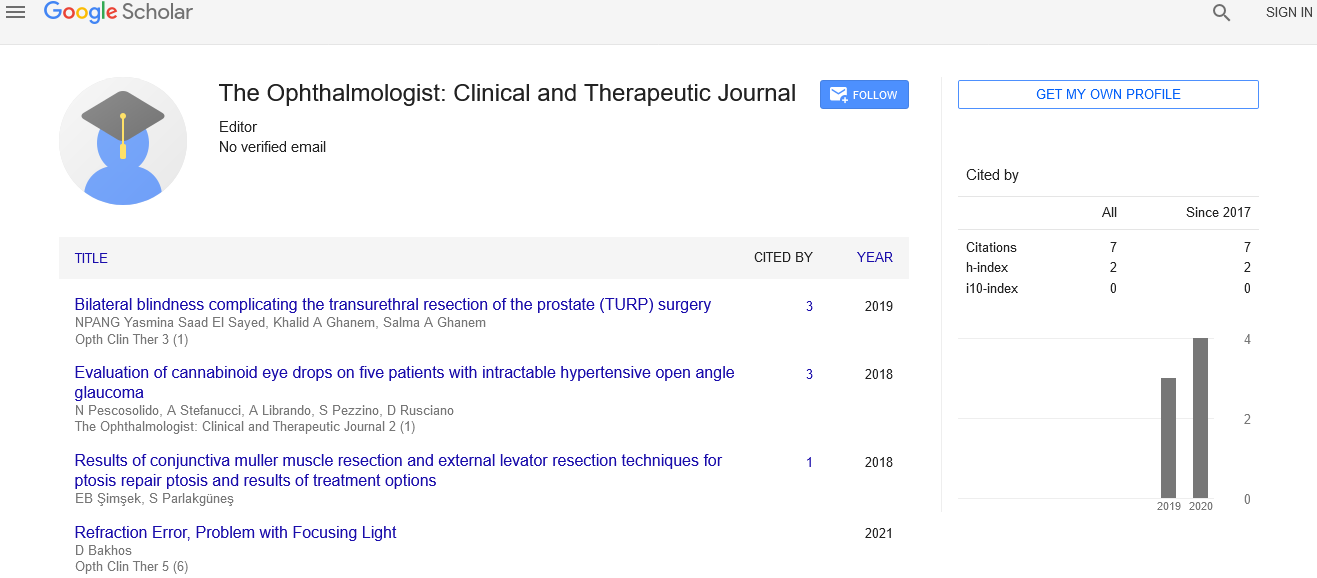Cone-rod dystrophy an inherited retinal disease
Received: 01-Dec-2021 Accepted Date: Dec 15, 2021; Published: 22-Dec-2021
Citation: Astrid Bergen. Con-rod dystrophy- An inherited retinal disease. Opth Clin Ther. 2021; 5(6):1
This open-access article is distributed under the terms of the Creative Commons Attribution Non-Commercial License (CC BY-NC) (http://creativecommons.org/licenses/by-nc/4.0/), which permits reuse, distribution and reproduction of the article, provided that the original work is properly cited and the reuse is restricted to noncommercial purposes. For commercial reuse, contact reprints@pulsus.com
Abstract
Cone-rod dystrophy (CRD) may be a cluster of inherited eye disorder that have an effect on the sensitive cells of the tissue layer known as the cones and rods. Cone dystrophy is a result of destruction to the cone cells of retinas. Individuals with this condition experience vision loss over time because the cones and rods deteriorate with time. It refers to a series of familial retinal disorders with earlier or preponderantly cone impairment and synchronic or subsequent less severe cone and rod impairment.
Keywords
Mutations; Photoreceptor; X- chromosome; Photophobia; Retinitis Pigmentosa.
Introduction
The retinas are the skinny layers of nerve cells that line the inner surface of the rear of the eyes. The tissue layer has two main forms of cells: cones and rods. CRDs are characterized by retinal pigment deposits visible on bodily structure examination, preponderantly localized to the macular region. Initial signs and symptoms of this diseases occur in childhood might contain attenuated sharpness of vision (visual acuity) and abnormal sensitivity to light (photophobia). These signs are sometimes followed by blind spots within the central field of vision (scotomas), loss of colour perception, and loss of visual modality. Most people with this condition became blind in their adulthood. CRDs rely on clinical history, anatomical structure examination and graphical record. Cone dystrophy may be a general term accustomed describes a bunch of rare eye disorders that have an effect on the cone cells of the tissue layer. There are two main varieties of cone dystrophy: stationary cone dystrophy and progressive cone dystrophy. In stationary cone dystrophy, symptoms tend to stay stable and are sometimes inherited at birth or infancy. In progressive cone dystrophy, symptoms slowly worsen over time. The age of onset, progression and severity of cone dystrophy will vary greatly from one person to a different, even among people with an equivalent form of cone dystrophy. The cone– rod dystrophies are less risky than Retinitis Pigmentosa (RP). In some cases, people experience deterioration of the cone cells additional severely than the rod cells. Inherited varieties of cone dystrophy are due to mutations in one among many genes that are connected to cone dystrophy. CRD is characterized by primary cone involvement, or, sometimes by major loss of each cones and rods that explains the predominant symptoms of CRDs: diminished visual sense, vision defects, photoaversion and diminished sensitivity within the central field of vision, later followed by progressive loss in visual sense. Infants wire by with caused CNGA3 mutations vital sometimes exhibit photophobia and move, that are noticed in 1st few months when birth. This diagnosing is formed on the idea of electrophysiology. Pure cone dystrophy is rare and typically rod involvement happens at some purpose. Clinical effects embrace loss of central visual sense, photophobia, and chromatic vision defects. Patients might have rod involvement at presentation or might develop it later. Early changes within the macula are discovered in affected people. In some patients, the tissue layer seems normal; however the graphical record continuously shows abnormalities. Dystrophy of the light-sensing cells of the attention might also occur within the rods or in each of the cones and rods. Diagnosing depends on recognition of the clinical constellation of symptoms and signs. The bodily structure test via ophthalmoscopy is basically traditional method cone dystrophy, and definite macular changes typically occur when once visual loss takes place. Fluorescein Angiography (FA) could be a helpful mechanism within the workup of somebody suspected to possess cone dystrophy; because it could notice early changes within the tissue layer which are too refined to be seen by medical instrument. Molecular diagnosing is created for a few genes. Ophthalmoscopes examine and reveals a standard anatomical structure or gentle devolution for this disease.
Conclusion
There’s no treatment for cone dystrophy, bound supplements could facilitate in delaying the progression of the wellness. In distinction to typical Retinitis Pigmentosa (RP), additionally referred to as the Rod Cone Dystrophies (RCDs) starting from the first loss in rod photoreceptors and later followed by the secondary loss in cone photoreceptors, CRDs replicate the other sequence of events. Cone–rod dystrophy make up may additionally be seen with specific mutations in genes that are usually related to different retinal diseases. Currently, there is no medical care that stops the evolution of these diseases or restores the vision.





